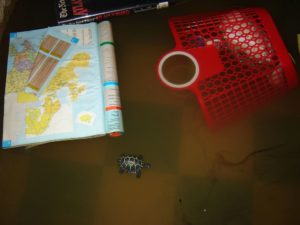What Do I Do If My Basement Floods?

It’s every homeowner’s nightmare: waking up to a new indoor pool in the lowest level of the house. But instead of swimming and enjoying it, the unlucky homeowner has to spend a ton of time getting rid of the water before it causes lasting damage. If your basement floods and all your personal belongings are down there, or – God forbid – the basement is finished, then there are many bigger problems to worry about.
So what do you do if this happens to you? Other than staying calm and carrying on, you have to get down to business and clean out that basement flooding. But you also have to do it safely!
So You’ve Noticed Basement Flooding: Safety First
 If you’re going to figure out where the water is coming from and how you’ll stop it, remember to be safe! Before venturing into your basement, make sure you are wearing proper protective equipment. Boots, eyewear, gloves, chest waders, even your lucky fisherman’s cap – put it on. You don’t want to come into contact with a hazardous material, slip on some wet concrete, or have more bad luck.
If you’re going to figure out where the water is coming from and how you’ll stop it, remember to be safe! Before venturing into your basement, make sure you are wearing proper protective equipment. Boots, eyewear, gloves, chest waders, even your lucky fisherman’s cap – put it on. You don’t want to come into contact with a hazardous material, slip on some wet concrete, or have more bad luck.
Next, think about your energy sources. Water that has come into contact with an electrical source is a hazard, as you probably know from grade school science that water is a fabulous conductor of electricity. This is why it’s important to shut off the power to the area pronto. Don’t do anything until you have confirmed the electricity has been shut off, and you should do the same for the gas.
Before you can solve the problem, you have to confirm the source of all that water. If it’s coming from a burst pipe, then shut off the water immediately; if it’s from stormwater, wait until it has passed. If it’s meltwater from snow, you can do your best to soak it up and prevent it from encroaching into your space.
Cleaning Out Basement Floods
You can begin cleaning out – wait, do you have a floor drain to mitigate basement floods? They can be very handy. Make sure it isn’t clogged, and if it is, clean it out. Now you can begin removing the water with whatever you have; a sump pump placed at the lowest point of your home is always good to have (and most home now do have them), but you can use a wet/dry vacuum, a mop and bucket, a pool pump, whatever you need to get rid of that water. Soak up what’s left and dry to remove the excess moisture by running a dehumidifier.
Hopefully, the floodwaters weren’t too deep, but even a small leak can bring serious property damage to your structure and the items in your basement. Here’s how to handle it:
- Move wet, damaged items out of the basement, and give them a good day or two to dry.
- Let large electronics dry where they stand, because moving them, even with the electricity disconnected, could pose a hazard.
- Remove items from wet cardboard boxes and toss the boxes away – they can grow mold or bacteria and spread them later.
- Disinfect the area after the basement has dried out. You don’t know what may have been brought in by the water.
- Apply a mold killing agent to your basement to prevent the growth of something that could pose a threat to your home and family’s health.
- Dispose of anything unusable, and recycle the appropriate items at your local waste management facilities.
After you’ve completed all this, you have to make sure that this never happens again! If you need help finding the source of the leak and your repair options, give us a call for a free, no-obligation quote.
